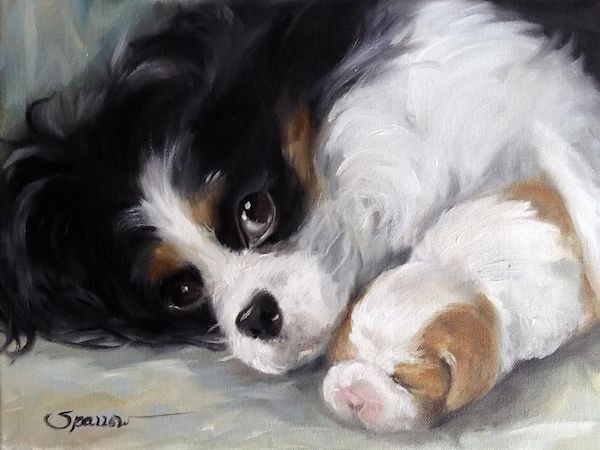
The Cavalier King Charles Spaniel comes in four gorgeous colors that appear in the breed standard, and a bit of cursory research revealed a few interesting things about them. We always defer to breed experts, so if we have this wrong, let us know!
Because of its breeding history as a popular breed during the Duke of Marlborough’s day, the most common of the four colors is Blenheim (chestnut markings on a white background that richen with age and is the “easiest” color genetic make up). The most uncommon color variety of the breed is Black and Tan (referred to as “King Charles” in the King Charles Spaniel breed), and it makes up one of two “solid” colors. The genetic combination for the Black and Tan is very complicated, and some sources maintain that it’s not just uncommon, it’s the rarest of the coat colors accepted by the AKC. The complex gene combination of Black and Tan Cavaliers offer the possibility of producing all four colors when bred with a Blenheim, but also the possibility of having puppies with mis-marks.
Again, whole colors are uncommon in the Cavalier world, and the other one is Ruby (a solid chestnut color). Of the two solid colors, it is the more frequently seen. A Ruby bred to a Ruby will produce all Ruby puppies, while a Ruby bred to a Black and Tan will produce either Ruby and Black and Tan puppies. When bred to a Blenheim, a Ruby can produce either Ruby or Blenheim colored puppies, and such a pairing can increase the richness of the color of the Blenheim pups, though some white mis-markings on the Ruby pups is possible (and they’re considered a fault under American Kennel Club conformation rules).
Of the four colors in the breed, the Tricolor dog’s markings will change the most. Black typically grows in on the white, and unless a Tri puppy’s white blaze is very broad at birth, it will usually fill in by his or her first birthday. Put another way, the wider the blaze at birth, the wider it will be as an adult.
The AKC does mention other colors in the breed that are not standard, namely chocolate, and chocolate and white, and we take this to mean that Cavs in chocolate or chocolate and white may be registered, but not shown in a conformation ring. To that end, there are other colors that also appear in the breed, but they can’t be registered, and one of them is merle. Merle does not exist in a properly bred Cavalier, it has to be introduced from another breed that carries the gene. Merle Cavaliers have a coat pattern characterized by irregular patches of diluted color in both solid color and parti coat types. It’s a color gimmick that only substandard breeders use.
Another is black & white. It’s quite rare to find a black & white Cavalier without some tan marking, and unlike the tricolor where black markings appear on a white background, black & white Cavaliers have more black color with white mis-markings on the chest, face, and feet.
A Cavalier in any accepted color is beautiful, though we confess that we find ruby-colored eyebrows in the Tricolor (referred to as the “Prince Charles” color in the King Charles Spaniel) hard to resist for giving the dog so much expression.
Image: Tricolor Cavalier King Charles Spaniel by Mary Sparrow / HangingtheMoonShelby
www.marysparrowsmith.net
www.etsy.com/shop/HangingtheMoonShelby

Merle is NOT an acceptable color
Just because you can mutate the other colors to create black and whites chocolates and Merles does not mean that it is correct
No argument from us, Kathy.
Mutations can occur. However sadly there are breeders trying to capitalize on producing incorrect ‘rare’ colors. To consistently get Merle typically it’s because of the introduction of another breed. Such as an Australian shepherd. For hundred of years. CKCS and ETS have only come in four colors. The introduction and breeding of other rare colors should never be encouraged.
Well stated.
What I can’t understand is a litter is born and there is a Merle pup in the mix. Everyone loves and praises the other puppies and accepts them as 100% KCC but the merle is ostracized & unregisterable, but the siblings are ?!
When a Merle Cavalier is born.. should it be destroyed? Is that your opinion? Are you standing that ALL MERLE CAVALIERS are unhealthy and 100% will have vision issues?
What do you say when DNA confirms a merle is 100% KCC. The DNA lineage proves that parents are in fact the AKC registered KCC’s. If that line can be traced back 30 lines? Are you still denying they are KCC?
Times are changing, KCC come in many colors. Just because the AKC doesn’t recognize them to “show” doesn’t mean they aren’t cavaliers. Please stop the hate against Merles that are DNA proven to be true KCC and allow them their place on this earth.
You’ll notice that we wrote, “A Cavalier in any color is beautiful,” but neither can we endorse the breeding of a color associated with soundness. Read up on this here: https://www.pawprintgenetics.com/products/tests/details/171/?breed=56
I have purebred akc registered ckcs. All litters have been in common colors akc registers. However this litter has more Merle than Blenheim. What happened? I did not change studs. The Sire is a AKC Blenheim . Now does this mean these pups are to be less valued?